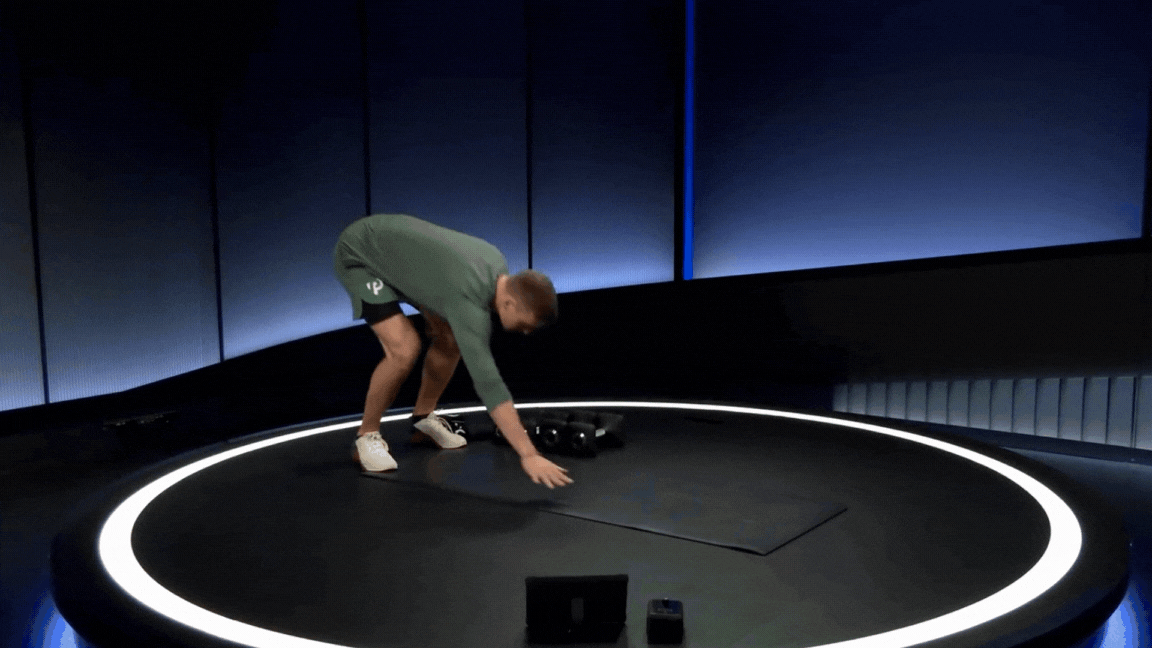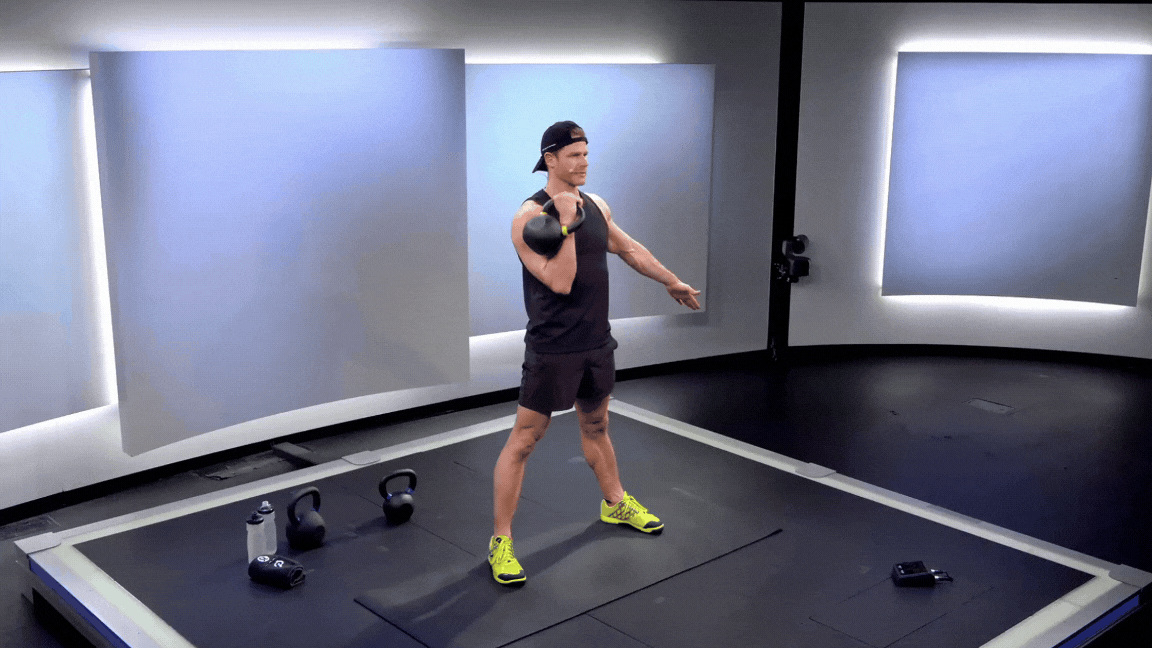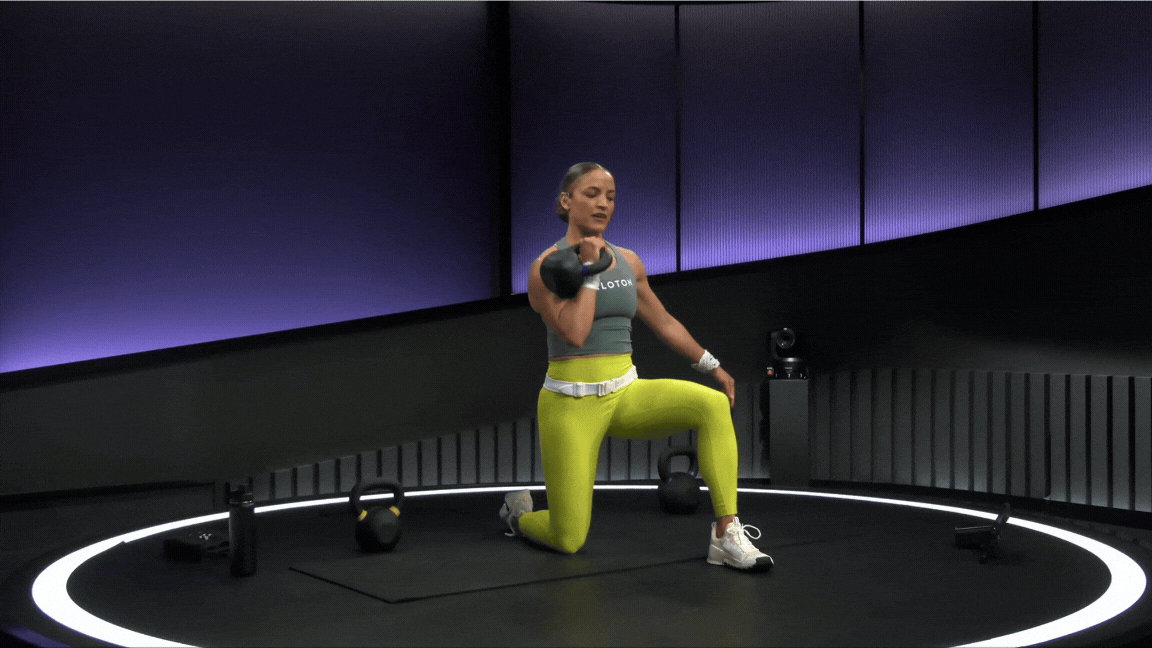
LaylaBird via Getty Images
The 9 Best Kettlebell Exercises for Stronger Arms
Kettlebells have some major advantages over dumbbells when it comes to building a tough upper body.
By Renee Cherry•
Why Should You Use Kettlebell Exercises for Arms?
How Often Should You Do Kettlebell Arm Exercises?
How to Warm Up for Upper Body Kettlebell Exercises
9 Most Effective Kettlebell Exercises for Arms
The Takeaway
Kettlebells are a staple in many big box gyms, boutique studios, and home workout spaces. With their rounded handles and compact profiles, they come in handy for all types of strength training. Whether you’re interested in building muscle, increasing core stability, or upping your heart rate, kettlebell exercises can be an efficient and powerful way to level up your training.
Discover more ways to reach your goals with Peloton
Though they may be best known for swinging and squatting, kettlebells can also be used to train your upper body. Next time you’re looking to burn out your biceps, triceps, or shoulders, consider picking up a bell—below, we have everything you need to know about kettlebell arm exercises, including which ones come recommended by Peloton instructor Joslyn Thompson-Rule.
Why Should You Use Kettlebell Exercises for Arms?
Machines, other free weights, and bodyweight training can all help you achieve stronger arms, but kettlebells have some unique advantages. They’re a popular piece of equipment used in functional strength training (that is, working out to condition your body for everyday movements) since you can use them in a variety of ways to build strength, power, endurance, and flexibility. Kettlebell exercises that incorporate explosive or swinging movements (like cleans or kettlebell swings) are especially helpful for building those functional fitness skills by activating the kinetic chain and improving neuromuscular coordination, according to a 2024 research review published in Cureus.
Maintaining your grasp on a kettlebell’s handle during workouts may also help you improve your grip strength, which is considered a hallmark of healthy aging. A 2022 study published in BMC Geriatrics explored the effects of six months of high-intensity kettlebell training on people ages 59 to 79, and found that it significantly improved their grip strength. The participants also experienced small-to-moderate improvements in cardiovascular fitness, body composition, and muscular strength and endurance.
If you’ve only ever used other types of weights for an upper body workout, reaching for a kettlebell on a whim can be mildly humbling. “There’s a misconception that kettlebells will be easy to navigate if you already work with dumbbells or barbells,” Joslyn says. “They definitely take a little getting used to, but are a fantastic tool.”
If you’re up for it, kettlebells can challenge your body in new ways thanks to their design. “They’re a different stimulus compared to dumbbells because of the weight distribution, and are more challenging, requiring increased core control to stabilize the movement,” Joslyn says.
The same can be said for other stabilizer muscles in your body. For example, performing a one-handed overhead press with a kettlebell will engage the stabilizer muscles in your shoulder more so than with a dumbbell, according to a 2022 study published in the journal Sensors. That’s because the center of mass is within the bell of the kettlebell, which hangs alongside your arm during an overhead press, forcing your shoulder muscles to counteract external rotation. (On the other hand, a dumbbell’s center of mass is within the handle, which lines up directly with your elbow during an overhead press.) Having stronger stabilizers helps protect your joints and keep them moving properly, helping to reduce the risk of injury.
How Often Should You Do Kettlebell Arm Exercises?
Generally speaking, Joslyn recommends incorporating kettlebell arm exercises one to two times per week, or whenever you’re training your upper body. How often you should incorporate resistance training sessions into your routine will depend on your current fitness level, goals, and preferences. As a general recommendation, the US Office of Disease Prevention and Health Promotion’s Physical Activity Guidelines for Americans suggests that adults incorporate at least two days per week of strength training sessions that hit all major muscle groups (along with 150 minutes per week of moderate-intensity cardio).
You might structure your routine with a workout split (e.g. a program that alternates between upper body and lower body days or push and pull movements) or simply do total body strength workouts every few days—how often you want to include kettlebell moves in those sessions is up to you. If you want to let someone else do the planning, try following a trainer-designed strength workout or program, like those offered in the Peloton App and Peloton Strength+.

Peloton App
Access thousands of classes with no equipment needed.
How to Warm Up for Upper Body Kettlebell Exercises
While it can be tempting to dive right in, it’s important to take a few minutes to warm up the muscles that you’ll be using during your upper body workout. Fitness experts often recommend dynamic warm-ups (vs static stretches that require you to hold still) to prepare your body physically and psychologically and reduce the risk of injury, according to a 2024 article in the journal Arthroscopy, Sports Medicine, and Rehabilitation.
Before an upper body kettlebell workout, you’ll want to get your arms moving along with other key players. “I would ensure the shoulders, spine, and overhead position are well warmed up,” Joslyn says. She suggests cycling through the following three exercises.

World’s Greatest Stretch
The world’s greatest stretch gets its name from the fact that it (nearly) does it all, stretching your hips, glutes, hamstrings, chest, back, and shoulders.
Start in a high plank position. Keeping your core engaged, step your right foot to the outside of your right hand, coming into a runner's lunge with your left leg straight.
Inhale and lift your right hand toward the ceiling, twisting your chest open to the right. Pause, then return to center, bringing your right hand back to the floor. (For an even deeper version of the world’s greatest stretch, you can also twist the other direction, reaching your right elbow toward the floor, before returning your right hand to plank position.)
Step your right foot back to meet your left, returning to a high plank position. Switch sides and repeat for two to five reps per side.

Bear Walkouts
This dynamic bear plank will light up your core while engaging most of the muscles in your upper body, including your chest, shoulders, triceps, and back.
Start on your hands and knees with your hands directly beneath your shoulders, and knees beneath your hips, bent at 90-degree angles. Tuck your toes and engage your core to lift your knees an inch off the floor.
Keeping your back straight and your core engaged, walk your hands forward until you’re in a high plank.
Hold for one second, then walk your hands backward to return to the starting position.

Kettlebell Halos
This kettlebell move is the ultimate shoulder warm-up, as it takes the joints through a huge range of motion, preparing them for whatever strength work lies ahead. Choose a lighter kettlebell (or dumbbell) for this exercise.
Hold a kettlebell upside down in front of your chest, grabbing one side of the handle in each hand, palms facing each other.
Keeping your wrists straight, rotate the kettlebell around your head. Move it from your left shoulder, behind your head, and around to your right shoulder, completing the rotation by bringing the kettlebell back to the starting position in front of your chest. Keep your core engaged throughout the movement; don’t allow your back to arch or ribs to flare open.
Repeat, rotating in the opposite direction.
9 Most Effective Kettlebell Exercises for Arms
It’s possible to use kettlebells for exercises that isolate your arm muscles (i.e., your biceps, triceps, and forearms), but Joslyn generally recommends tapping them for exercises that work your entire upper body. “When selecting my favorite kettlebell arm exercises, I lean more toward compound moves (like presses, rows, etc.) as I think they’re safer,” she says. “I would be less inclined to do isolated movements like biceps curls with them—for that, I prefer dumbbells.”
Here’s a breakdown of how to do Joslyn’s nine favorite upper body kettlebell exercises:

Single-Arm Kettlebell Overhead Press
The single-arm kettlebell overhead press—similar to one you’d do with a dumbbell—mainly works your shoulders, triceps, and traps (part of your upper back).
Stand with your feet hip-width apart, and a kettlebell racked in your left arm at shoulder height. Keep your elbow close to your body with your palm facing in.
Press the kettlebell overhead, turning your palm to face forward. Engage your glutes and core and try not to arch your back.
Lower the kettlebell with control, bending your left elbow to return to the starting position. Do the same number of reps on both sides.
Dual Kettlebell Overhead Press
This exercise is similar to the single-arm kettlebell overhead press, but you’ll use two kettlebells to work both arms at the same time.
Stand with your feet hip-width apart, and one kettlebell in each hand racked at shoulder height, your elbows tucked in close to your body.
Press the kettlebells overhead, engaging your glutes and core. Avoid arching your back or letting your ribs flare open. At the top of the movement, your hands should be stacked directly over your shoulders, palms facing forward.
Bend your elbows to lower the kettlebells with control and return to the starting position.

Half-Kneeling Kettlebell Overhead Press
When you perform an overhead press in a half-kneeling stance, it also challenges your core stability.
Start in a half kneeling position, with your right leg in front and your left leg behind with your left knee on the floor. Both knees should be bent at 90 degrees. Hold a kettlebell in your left hand racked at shoulder height, palm facing in.
Keeping your core engaged, press the bell overhead so your left hand is directly above your shoulder, palm facing forward. Keep your core engaged, and try not to arch your back. If it helps, you can extend your right arm out to the side for balance.
Bend your left elbow to lower the kettlebell with control and return to the starting position. Do the same number of reps on both sides.
Kettlebell Bent-Over Row
Bent-over rows work your back, shoulders, biceps, and core. You can do this move one side at a time or with a kettlebell in each hand.
Stand with your feet hip-width apart, holding a kettlebell by the handle in your left hand, hanging by your side. With your knees slightly bent and your back straight, engage your core and hinge at your hips until your torso is almost parallel to the ground. Allow the kettlebell to hang directly below your left shoulder.
Maintaining the hinge position and keeping your shoulders square, draw your left elbow backward to row the kettlebell up toward your left ribs.
Lower the kettlebell to the floor to return to the starting position. That’s one rep. Do the same number of reps on both sides.

Kettlebell Gorilla Row
Gorilla rows are similar to bent-over rows, but you rest the kettlebells on the ground between reps. To get low enough to reach the handles, you’ll likely need to widen your stance and more deeply bend at your knees and hips.
Stand with your feet wider than shoulder-width apart, with two kettlebells on the floor between your feet. Bend your knees and hinge at your hips to grab one handle in each hand with your palms facing in.
With your core engaged and back flat, draw your left elbow backward to row the kettlebell up toward your left ribs.
Lower the kettlebell with control to the floor, then repeat on the other side. Continue alternating. Do the same number of reps on both sides.
Kettlebell Biceps Curl
Joslyn isn’t a big fan of single-arm kettlebell biceps curls because of the kettlebell’s shape, but she likes this two-handed version of the classic arm exercise.
Stand with your feet hip-width apart, holding a kettlebell in front of your hips, with your hands on either side of the handle. (If it’s more comfortable, you can also hold the horns or the bell of the kettlebell.)
Bend your elbows to curl the kettlebell up towards your chest, keeping your wrists straight, elbows close to your body, and your core engaged.
Slowly lower the kettlebell to return to the starting position.

Kettlebell Push Press
A push press is like an overhead press, but you leverage a slight bend in your knees to explosively push the weight above your head.
Stand with your feet hip-width apart and a kettlebell in your left hand, racked at shoulder height with your left elbow close to your body.
Keeping your core engaged, bend your knees slightly, then explosively extend your hips and knees, using the momentum to press the kettlebell overhead. Your hand should be stacked directly over your shoulder at the top of the movement.
Lower the kettlebell with control to return to the starting position, bending your knees to absorb the weight. That’s one rep. Do the same number of reps on both sides.
Kettlebell Floor Press
A floor press offers more shoulder support and allows for a more limited range of motion compared to a bench press. You can do this move one side at a time or work your whole chest at once by holding a kettlebell in each hand.
Lie down on your back with your legs bent and feet flat on the floor. Hold a kettlebell by the handle in your left hand with your arm extended straight up toward the ceiling, maintaining a straight wrist.
Lower your left elbow toward the floor so your upper arm makes a 45-degree angle with your torso (not straight out to the side). Pause when your upper arm touches the floor.
Press the kettlebell back up to the starting position, maintaining a straight wrist throughout. That’s one rep. Do the same number of reps on both sides.

Kettlebell Lawn Mower Row
During a lawn mower row (also called a single-arm row), you’ll stand in a static lunge and row a weight on one side as though you’re pulling a lawn mower’s handle to start it.
Stand with your feet together, holding a kettlebell in your right hand by your side. Take a big step backward with your right foot, bending your left knee into a lunge and placing your left elbow on your left knee.
Keeping your core engaged, your back straight, and your shoulders square, draw your right elbow backward to row the kettlebell up toward your right ribs.
Lower the kettlebell with control to return to start. That’s one rep. Do the same number of reps on both sides.
The Takeaway
Kettlebells have a bit of a learning curve, but they’re worth the effort when improving your functional fitness is a priority. While kettlebells aren’t Joslyn’s top choice for arm isolation exercises, she loves the weights for compound movements that fire up muscles throughout your upper body. If you'd like a little more guidance in mastering the moves, Peloton's new kettlebell classes, available on the Peloton App under the Kettlebells Collection, have exactly what you're looking for.
Whether you're pressing, rowing, or curling, the unique shape and weight distribution of a kettlebell challenge your stability and coordination in ways that dumbbells just can’t—and that should be the only motivation you need to add them to your next workout.
This content is for informational and educational purposes only and does not constitute individualized advice. It is not intended to replace professional medical evaluation, diagnosis, or treatment. Seek the advice of your physician for questions you may have regarding your health or a medical condition. If you are having a medical emergency, call your physician or 911 immediately.
Level up your inbox.
Subscribe for a weekly dose of fitness, plus the latest promos, launches, and events.
By providing your email address, you agree to receive marketing communications from Peloton.
For more about how we use your information, see our Privacy Policy.












